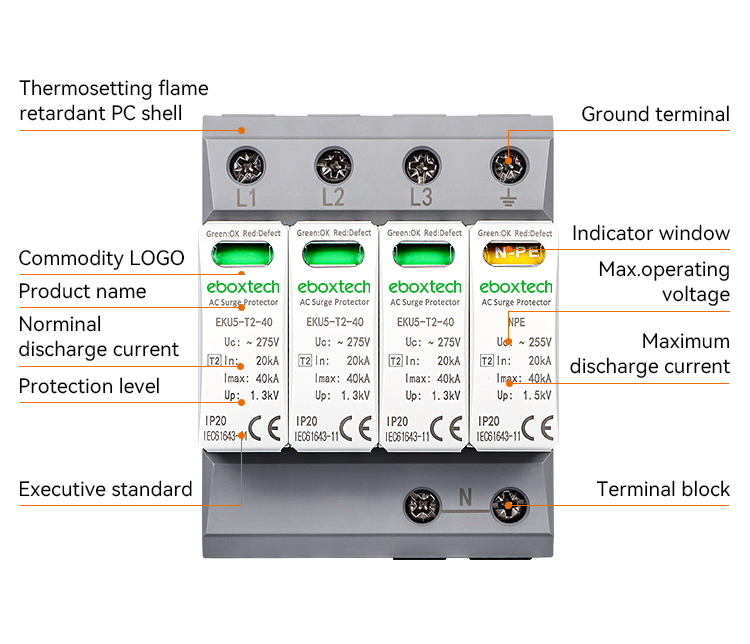Illustrated Guide to Interpreting and Selecting Surge Protector (SPD) Parameters
Electronic products are often exposed to various transient voltage surges, such as those caused by lightning or static electricity, which can lead to circuit malfunctions or damage. Correct selection and use of surge protection devices (SPDs) are critical to safeguarding equipment and ensuring personal safety.
Surge Protection Devices (SPDs), often referred to as "lightning arresters" or "overvoltage protectors," limit transient overvoltages entering power lines or signal transmission lines to within the voltage range that equipment or systems can tolerate. Alternatively, they discharge powerful lightning currents to the ground, protecting equipment or systems from damage.
EBOXTECH, to provide from product development, production to engineering design, construction and testing services integration of the whole industry chain services, and strive to become the leading brand of this professional ability of the industry, the product through the CCC, CQC, CE, ROHS and other certificates for more than a million users to provide professional lightning protection products and services.
01 SPD Classification by Levels
The immense energy of lightning necessitates a staged discharge approach to dissipate it progressively to the ground:
- Class I Surge Protectors:
- Designed for direct lightning current discharge or handling the large energy conducted when power transmission lines are struck directly by lightning.
- Require a maximum impact capacity of ≥100 kA per phase.
- Limit voltage to less than 2500V.
(2)Class II Surge Protectors:
- Protect against residual voltage from upstream surge protectors and induced lightning within the protected zone.
- Handle high-energy residual lightning from upstream devices.
- Key parameters:
Lightning current capacity: ≥40 kA (8/20μs).
Residual voltage peak: ≤1000V.
Response time: ≤25ns.
(3)Class III Surge Protectors:
- Reduce residual surge voltage to below 1000V, ensuring that energy does not damage equipment.
- Lightning current capacity: ≥10 kA.
- Essential for critical or sensitive electronic equipment.
- Provides protection against transient overvoltages generated internally within systems.
02 Interpretation of SPD Parameters

-
(1) Nominal Voltage (Un): The rated voltage of the system to be protected, indicating the type of SPD needed. Specifies the effective AC or DC voltage.
(2) Maximum Continuous Operating Voltage (Uc): The highest voltage the SPD can withstand indefinitely without degrading its characteristics or activating protection components.
(3) Nominal Discharge Current (In): The peak surge current an SPD can endure for 10 strikes using an 8/20μs waveform.
(4) Maximum Discharge Current (Imax): The highest surge current the SPD can handle for a single strike using an 8/20μs waveform.
(5) Voltage Protection Level (Up): The maximum voltage during testing, determined by:
- Sparkover voltage at a 1 kV/μs slope.
- Residual voltage at the nominal discharge current.
(6) Response Time (tA): Measures the sensitivity and activation time of protection components within the SPD, influenced by the slope of du/dt or di/dt.
(7) Maximum Longitudinal Discharge Current: The peak surge current (8/20μs) the SPD can discharge between each line and the ground.
(8) Maximum Transverse Discharge Current: The peak surge current (8/20μs) the SPD can discharge between lines.
03 Selecting SPDs
Effective dissipation of lightning energy requires staged discharge protection:
- At LPZ0A (non-protected zone) or LPZ0B (protected zone) transitioning to LPZ1: Install Type 1 SPDs or voltage-limiting SPDs for the first stage of protection, discharging direct lightning current.
- At LPZ1 and subsequent zones: Install voltage-limiting SPDs to progressively discharge energy, providing second, third, or even higher levels of protection.
For equipment with low voltage tolerance, four or more stages of protection may be required.
04 Advantages of SPDs with Remote Signaling Contacts
(1) What are Remote Signaling Terminals?Remote signaling is a mechanism that provides alert signals. Typically, it connects to the internal tripping device of the SPD. Under normal conditions, it outputs a short-circuit signal. When the SPD overheats and the tripping device is activated, the remote signaling device (relay) sends an open-circuit signal to the monitoring system.

(2)Benefits of SPDs with Remote Signaling Terminals:
- Provides real-time status updates of the SPD.
- Alerts maintenance personnel to replace damaged SPDs promptly, preventing lightning-related accidents.
- Dual-warning systems, such as intelligent SPD monitoring devices and remote signaling-enabled SPDs, help detect SPD failure, ensuring continuous equipment safety.
Surge Protection Device (SPD) in the line protection plays a pivotal role, once the damage is not replaced in a timely manner, will endanger the safe operation of electrical equipment, so the maintenance staff must keep abreast of the surge protector related situations, and intelligent SPD online monitor and surge protector with a telecommunication terminal can be a solution to the damage of the surge protector is not known, double warning preparedness!


